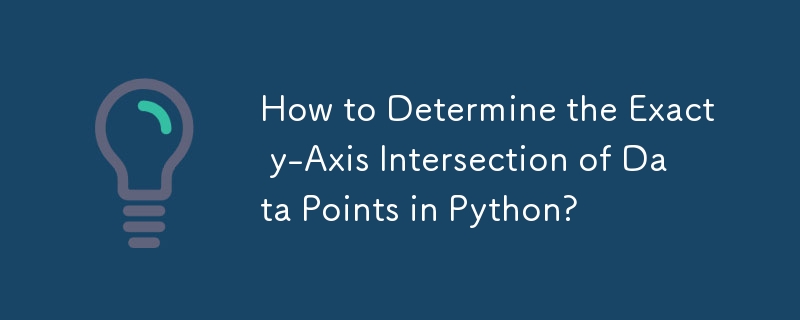

Beim Zeichnen von Daten in Python kann es nützlich sein, den genauen Wert zu erhalten, an dem eine Kurve die schneidet y-Achse. Dieser Wert kann mit numerischen Methoden ermittelt werden, insbesondere durch lineare Interpolation.
Der folgende Code zeigt, wie man die Nulldurchgänge eines Datenarrays mithilfe linearer Interpolation findet:
<code class="python">import numpy as np
# Generate sample data
N = 750
x = .4 + np.sort(np.random.rand(N)) * 3.5
y = (x - 4) * np.cos(x * 9.) * np.cos(x * 6 + 0.05) + 0.1
# Define function to find roots (zero crossings)
def find_roots(x, y):
s = np.abs(np.diff(np.sign(y))).astype(bool)
return x[:-1][s] + np.diff(x)[s]/(np.abs(y[1:][s]/y[:-1][s])+1)
# Find zero crossings
z = find_roots(x, y)
# Plot data and zero crossings
import matplotlib.pyplot as plt
plt.plot(x, y)
plt.plot(z, np.zeros(len(z)), marker="o", ls="", ms=4)
plt.show()</code>Die obige Methode kann geändert werden, um Schnittpunkte bei y-Werten ungleich Null (y0) zu finden, indem die Nullstellen von y ermittelt werden - y0:
<code class="python">y0 = 1.4 z = find_roots(x, y - y0) plt.plot(z, np.zeros(len(z)) + y0)</code>
Ähnlich wie bei der ersten Methode umfasst das Ermitteln des Schnittpunkts zwischen zwei Kurven das Ermitteln der Nullstellen der Differenz zwischen den beiden Datenfeldern:
<code class="python"># Generate sample data x = .4 + np.sort(np.random.rand(N)) * 3.5 y1 = (x - 4) * np.cos(x * 9.) * np.cos(x * 6 + 0.05) + 0.1 y2 = (x - 2) * np.cos(x * 8.) * np.cos(x * 5 + 0.03) + 0.3 # Find intersection points z = find_roots(x, y2 - y1) # Plot data and intersection points plt.plot(x, y1) plt.plot(x, y2, color="C2") plt.plot(z, np.interp(z, x, y1), marker="o", ls="", ms=4, color="C1")</code>
Das obige ist der detaillierte Inhalt vonWie bestimme ich den genauen Y-Achsen-Schnittpunkt von Datenpunkten in Python?. Für weitere Informationen folgen Sie bitte anderen verwandten Artikeln auf der PHP chinesischen Website!
 Der Unterschied zwischen Konsolenkabel und Netzwerkkabel
Der Unterschied zwischen Konsolenkabel und Netzwerkkabel
 So können Sie den Gasverbrauch nach der Zahlung wieder aufnehmen
So können Sie den Gasverbrauch nach der Zahlung wieder aufnehmen
 Fil-Coin-Preis heute
Fil-Coin-Preis heute
 So beheben Sie den Fehler bei der Website-Wiederherstellung
So beheben Sie den Fehler bei der Website-Wiederherstellung
 CSS-Hintergrundcode-Sammlung
CSS-Hintergrundcode-Sammlung
 Was ist der Grund, warum der Computerbildschirm schwarz ist, der Computer jedoch eingeschaltet ist?
Was ist der Grund, warum der Computerbildschirm schwarz ist, der Computer jedoch eingeschaltet ist?
 Wie hoch ist das Überweisungslimit von Alipay?
Wie hoch ist das Überweisungslimit von Alipay?
 Absolute Referenzeingabemethode
Absolute Referenzeingabemethode




